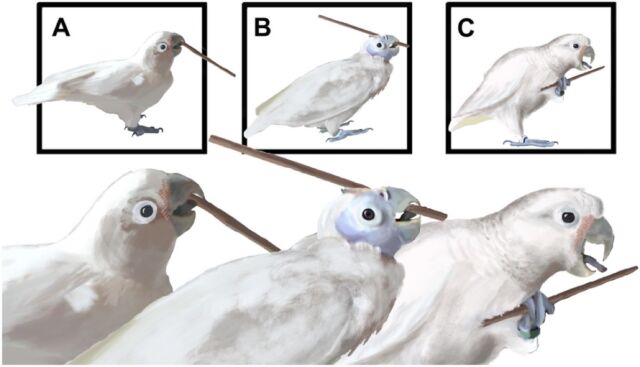Several years ago, we introduced Ars readers to Figaro, a precocious male Goffin's cockatoo kept in captivity and cared for by scientists in the "Goffin lab" at the University of Veterinary Medicine in Vienna. Figaro showed a surprising ability to manipulate single tools to maneuver a tasty nut out of a box. Other cockatoos who repeatedly watched Figaro's performance were also able to do so. Now, Figaro and his cockatoo cronies are back, having learned how to combine tools—in this case, a stick and a ball—to play a rudimentary form of "golf," according to a new paper published in the journal Scientific Reports.
As Ars' Science Editor John Timmer explained in 2012, tool use was once thought to be one of the defining features of humans, but examples of it were eventually observed in primates and other mammals. Then birds were observed using tools in the wild, although this behavior was limited to corvids (crows and jays). Parrots, by contrast, have mostly been noted for their linguistic skills, and there has only been limited evidence that they use anything resembling a tool in the wild. Primarily, they seem to use external objects to position nuts while feeding.
Then along came Figaro. Figaro was playing with a stone one day in the Goffin Lab at the University of Vienna's Department of Cognitive Biology, led by Alice Auersperg. He accidentally dropped the stone behind a metal divider.
The wily bird couldn't retrieve it using just his claw, so he found a piece of bamboo and tried to use it to push the stone to within reach. He failed, but the researchers were sufficiently intrigued that they decided to test Figaro by placing a delicious nut on the other side of the metal screen.

A stick retrieved from the floor was too short to retrieve the nut, so Figaro splintered off a longer piece of wood from the enclosure's wooden base. This time, he succeeded in pulling the nut close enough that he could use his beak to grab it. In subsequent trials, Figaro used different types of tools—modifying some of them—to successfully retrieve the nut.
The researchers concluded that tool use is within the cognitive capacity of this species, even though the birds have never been observed using tools in the wild. They argued that although we tend to think of tool use as a distinctive mental capacity, it might be more accurate to consider it as a possible outcome of having some minimum level of what the researchers call "physical intelligence." Goffin’s cockatoos don't normally exercise this capacity, but under the right circumstances, it can be uncovered.
Two years later, the same team was back with fresh insights: other male cockatoos who watched Figaro's innovative use of tools to retrieve a nut began to catch on and exhibit similar behavior. They didn't exactly mimic Figaro's approach—he tended to rake the food closer, while the others used the stick as a lever to flick the food to the edge of the cage—but they definitely began to obtain the treat.
Sometimes the birds would lose a tool, leaving it out of reach inside the cage. In that case, they'd reach for another tool but wouldn't use it to retrieve the food—instead, they'd retrieve the first tool, then use that to get the food. One individual went three layers deep into this sort of recursion.

In subsequent experiments, one of the other males spontaneously started making tools by pulling splinters off the block of wood after just a few sessions. The third only needed to see Figaro perform a single tool manufacturing demo before he also picked up the habit. The results suggested that learning tool creation is much easier than learning tool use, at least once the utility of a tool had been demonstrated.
This was followed by a 2020 study comparing the captive-bred cockatoos' problem-solving abilities with those of wild birds caught in Tanimbar. The birds were presented with a series of 20 different tasks they could choose to complete in exchange for a nut reward. While the wild birds were less likely to participate in the tasks, those that did were able to solve the problems at the same rate as the captive birds.
Other experiments have shown that the cockatoos are capable of a measure of self-control and delaying gratification. This is evidenced by their ability to resist the temptation to eat a pecan nut for as long as 80 seconds in exchange for a tastier cashew reward, in a bird-centric version of the famous Stanford Marshmallow experiment.



3175x175(CURRENT).thumb.jpg.b05acc060982b36f5891ba728e6d953c.jpg)


Recommended Comments
There are no comments to display.
Join the conversation
You can post now and register later. If you have an account, sign in now to post with your account.
Note: Your post will require moderator approval before it will be visible.